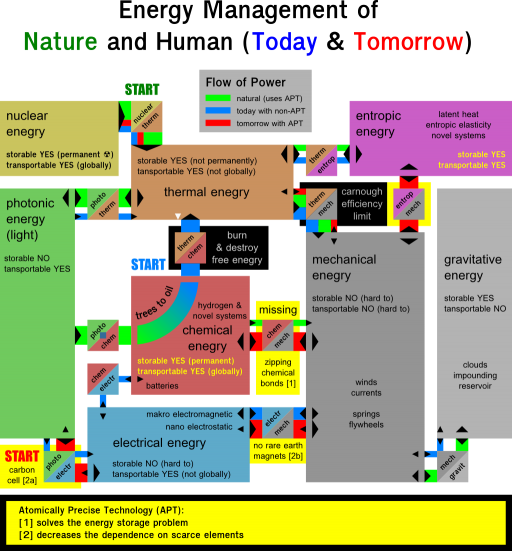Difference between revisions of "Energy conversion"
(→Mesoscale: added thermoelectric and thermoentropic converters and more) |
m (fixed headline hierarchy) |
||
| Line 46: | Line 46: | ||
the conversion can be near reversible given thermal isolation is really good. | the conversion can be near reversible given thermal isolation is really good. | ||
| − | == Thermoelectric converters == | + | === Thermoelectric converters === |
These fall squarely under the [[non mechanical technology path]]. <br> | These fall squarely under the [[non mechanical technology path]]. <br> | ||
| Line 53: | Line 53: | ||
beyond the very limited set of accessible structures that we can reach today with only [[thermodynamic means]]. | beyond the very limited set of accessible structures that we can reach today with only [[thermodynamic means]]. | ||
| − | == Thermoentropic converters == | + | === Thermoentropic converters === |
That's basically storing thermal energy into phase changes. <br> | That's basically storing thermal energy into phase changes. <br> | ||
Revision as of 20:09, 14 June 2021
Atomically precise technology for energy conversion can:
- solve the enegry storage problem making renewable energy storable and fossile or nuclear fission baseload power plants unnecessary
- circumvent burning processes that unnecessarily devaluates energy
[Todo: add infographic]
Different power converters have heterogeneity residing on different size scales.
Contents
Nanoscale: molecular power converters
AP technology provides several possibilities for energy conversion that work in a mill/zip/conveyor belt like style:
- chemomechanical converters – the link for massive and efficient energy storage that is missing today (2021)
- electromechanical converters – two types?
- entropomechanical converters – storing energy into molecular order into squeezing out molecular degrees of freedom
- Diamondoid solar cells – optoelectric/solarelectric converters
- Atomically precise electrochemical converters – basically batteries when there is atomically precise control over matter
- mechanoradio and radiomechanical conversion
– spinning electrical dipoles really fast mechanically
– the limit might be somewhere at 100GHz? (nanoscale levitation likely needed to limit friction at speeds close to the unsupported rotating ring speed limit) - mechanooptical conversion – this is very new – exciting elecronic stated by force applying mechanic manipulation on bound molecules
- optomechanical conversion – basically photochemistry – causing a conformational change through electronic structure change through optical excitation
The teraherz gap between radio frequencies and far infrared frequencies
- is too high for generation by moving charges mechanically and also
- is challenging to cover even from the electronic side – (non mechanical technology path)
Mesoscale
All thermo involving energy conversion processes are at least mesoscale since thermal isolation is needed
and thermal isolation does not work well at the nanoscale due to the large surface to volume ratios that are present there (scalng law).
Thermomechanical concerters
- thermomechanical converters – (diamondoid heat pump systems)
Used base technologies for such heat pump systems can be:
Note that although the efficiency of heat pumps is fundamentally limited by the Carnough-cycle
the conversion can be near reversible given thermal isolation is really good.
Thermoelectric converters
These fall squarely under the non mechanical technology path.
Reaching high efficiencies is difficult.
We'll see what we can do once we can make much more materials via piezochemical mechanosynthesis
beyond the very limited set of accessible structures that we can reach today with only thermodynamic means.
Thermoentropic converters
That's basically storing thermal energy into phase changes.
Existing technology. We'ss see how gem-gum technology can improve on that.
Macroscale
Thermonuclear conversion (or rather nuclearthermo conversion)
Complex macroscopic systems made from advanced diamondoid metamaterials may lead to significant improvements here.
See main page: APM and nuclear technology
- There are some exotic approaches for partially direct nuclearelectric conversion perhaps allowing to go beyond the Carnough limit in efficiency.
- Direct nuclearmechanical seems not possible or sensible.
Gravomechanical conversion
Given gravity is a macroscopic phenomenon the technology is inherently macroscopic.
Nothing much new here with gem-gum technology.
Well space elevators maybe. But these are difficult.
Related
External links
- Wikipedia: transducer, actuators, ...
